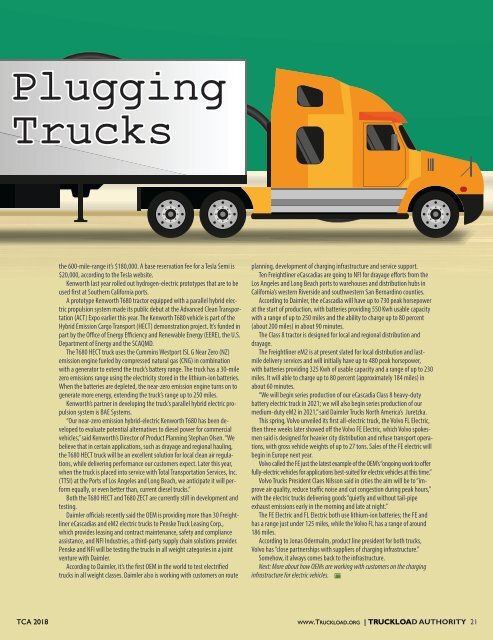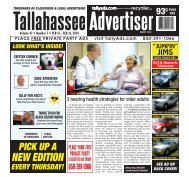Truckload Authority - August/September 2018
Create successful ePaper yourself
Turn your PDF publications into a flip-book with our unique Google optimized e-Paper software.
the 600-mile-range it’s $180,000. A base reservation fee for a Tesla Semi is<br />
$20,000, according to the Tesla website.<br />
Kenworth last year rolled out hydrogen-electric prototypes that are to be<br />
used first at Southern California ports.<br />
A prototype Kenworth T680 tractor equipped with a parallel hybrid electric<br />
propulsion system made its public debut at the Advanced Clean Transportation<br />
(ACT) Expo earlier this year. The Kenworth T680 vehicle is part of the<br />
Hybrid Emission Cargo Transport (HECT) demonstration project. It’s funded in<br />
part by the Office of Energy Efficiency and Renewable Energy (EERE), the U.S.<br />
Department of Energy and the SCAQMD.<br />
The T680 HECT truck uses the Cummins Westport ISL G Near Zero (NZ)<br />
emission engine fueled by compressed natural gas (CNG) in combination<br />
with a generator to extend the truck’s battery range. The truck has a 30-mile<br />
zero emissions range using the electricity stored in the lithium-ion batteries.<br />
When the batteries are depleted, the near-zero emission engine turns on to<br />
generate more energy, extending the truck’s range up to 250 miles.<br />
Kenworth’s partner in developing the truck’s parallel hybrid electric propulsion<br />
system is BAE Systems.<br />
“Our near-zero emission hybrid-electric Kenworth T680 has been developed<br />
to evaluate potential alternatives to diesel power for commercial<br />
vehicles,” said Kenworth’s Director of Product Planning Stephan Olsen. “We<br />
believe that in certain applications, such as drayage and regional hauling,<br />
the T680 HECT truck will be an excellent solution for local clean air regulations,<br />
while delivering performance our customers expect. Later this year,<br />
when the truck is placed into service with Total Transportation Services, Inc.<br />
(TTSI) at the Ports of Los Angeles and Long Beach, we anticipate it will perform<br />
equally, or even better than, current diesel trucks.”<br />
Both the T680 HECT and T680 ZECT are currently still in development and<br />
testing.<br />
Daimler officials recently said the OEM is providing more than 30 Freightliner<br />
eCascadias and eM2 electric trucks to Penske Truck Leasing Corp.,<br />
which provides leasing and contract maintenance, safety and compliance<br />
assistance, and NFI Industries, a third-party supply chain solutions provider.<br />
Penske and NFI will be testing the trucks in all weight categories in a joint<br />
venture with Daimler.<br />
According to Daimler, it’s the first OEM in the world to test electrified<br />
trucks in all weight classes. Daimler also is working with customers on route<br />
planning, development of charging infrastructure and service support.<br />
Ten Freightliner eCascadias are going to NFI for drayage efforts from the<br />
Los Angeles and Long Beach ports to warehouses and distribution hubs in<br />
California’s western Riverside and southwestern San Bernardino counties.<br />
According to Daimler, the eCascadia will have up to 730 peak horsepower<br />
at the start of production, with batteries providing 550 Kwh usable capacity<br />
with a range of up to 250 miles and the ability to charge up to 80 percent<br />
(about 200 miles) in about 90 minutes.<br />
The Class 8 tractor is designed for local and regional distribution and<br />
drayage.<br />
The Freightliner eM2 is at present slated for local distribution and lastmile<br />
delivery services and will initially have up to 480 peak horsepower,<br />
with batteries providing 325 Kwh of usable capacity and a range of up to 230<br />
miles. It will able to charge up to 80 percent (approximately 184 miles) in<br />
about 60 minutes.<br />
“We will begin series production of our eCascadia Class 8 heavy-duty<br />
battery electric truck in 2021; we will also begin series production of our<br />
medium-duty eM2 in 2021,” said Daimler Trucks North America’s Juretzka.<br />
This spring, Volvo unveiled its first all-electric truck, the Volvo FL Electric,<br />
then three weeks later showed off the Volvo FE Electric, which Volvo spokesmen<br />
said is designed for heavier city distribution and refuse transport operations,<br />
with gross vehicle weights of up to 27 tons. Sales of the FE electric will<br />
begin in Europe next year.<br />
Volvo called the FE just the latest example of the OEM’s “ongoing work to offer<br />
fully-electric vehicles for applications best-suited for electric vehicles at this time.”<br />
Volvo Trucks President Claes Nilsson said in cities the aim will be to “improve<br />
air quality, reduce traffic noise and cut congestion during peak hours,”<br />
with the electric trucks delivering goods “quietly and without tail-pipe<br />
exhaust emissions early in the morning and late at night.”<br />
The FE Electric and FL Electric both use lithium-ion batteries; the FE and<br />
has a range just under 125 miles, while the Volvo FL has a range of around<br />
186 miles.<br />
According to Jonas Odermalm, product line president for both trucks,<br />
Volvo has “close partnerships with suppliers of charging infrastructure.”<br />
Somehow, it always comes back to the infrastructure.<br />
Next: More about how OEMs are working with customers on the charging<br />
infrastructure for electric vehicles.<br />
TCA <strong>2018</strong> www.<strong>Truckload</strong>.org | TRUCKLOAD AUTHORITY 21

















